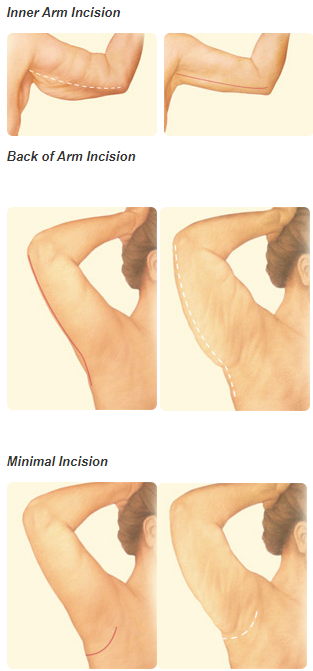Brachioplasty in Memphis
Fluctuations in weight, growing older, and heredity can cause your upper arms to have a drooping, sagging appearance. This is a condition that cannotbe corrected through exercise. If the underside of your upper arms are sagging or appear loose and full due to excess skin and fat, an arm lift may be right for you.
An arm lift, or brachioplasty, is a surgical procedure that:
- Reduces excess sagging skin that droops downward
- Tightens and smoothes the underlying supportive tissue that defines the shape of the upper arm
- Reduces localized pockets of fat in the upper arm region
In general, candidates for an arm lift include:
- Adults with significant upper arm skin laxity
- Adults of any age whose weight is relatively stable and who are not significantly overweight
- Healthy individuals without medical conditions that impair healing or increase risk of surgery
- Non-smokers
- Individuals with a positive outlook and realistic expectations

Consultation and Preparing for Surgery
- Your surgical goals
- Medical conditions, drug allergies, and medical treatments
- Current medications, vitamins, herbal supplements, alcohol, tobacco, and drug use
- Previous surgeries
- Evaluate your general health status and any pre-existing health conditions or risk factors
- Take photographs
- Discuss your options
- Discuss likely outcomes of arm lift surgery and any risks or potential complications
- Get lab testing or a medical evaluation
- Take certain medications or adjust your current medications
- Stop smoking
- Avoid taking aspirin, anti-inflammatory drugs, and herbal supplements as they can increase bleeding
The Procedure

Risks and Safety
The decision to have arm lift surgery is extremely personal, and you’ll have to decide if the benefits, risks and potential complications are acceptable. You will be asked to sign consent forms to ensure that you fully understand the procedure.
The risks include:
- Anesthesia risks
- Bleeding
- Infection
- Poor wound healing
- Unsightly scarring
- Fluid accumulation (seroma)
- Damage to deeper structures such as nerves, blood vessels and muscles
- Fatty tissue under the skin might die (fat necrosis)
- Numbness or other changes in skin sensation
- Pain, which may persist
- Sutures may not absorb, but spontaneously surface through the skin, causing irritation, drainage and redness
- Possible need for revisional surgery
These risks and others will be fully discussed prior to your consent. It’s important that you address all your questions directly with your plastic surgeon.
Recovery After Surgery
Following your surgery, dressings or bandages may be applied to your incisions, and your arms may be wrapped in an elastic bandage or a compression garment to minimize swelling. A small, thin tube may be temporarily placed under the skin to drain any excess blood or fluid.
You will be given specific instructions on how to care for the surgical site and drains, medications to apply or take orally to aid healing, specific concerns to look for, and when to follow up with your plastic surgeon.
Be sure to ask your plastic surgeon specific questions about what you can expect during your individual recovery period.
- Where will I be taken after my surgery is complete?
- What medication will I be given or prescribed after surgery?
- Will I have dressings/bandages after surgery?
- When will they be removed?
- Are stitches removed? When?
- When can I resume normal activity and exercise?
- When do I return for follow-up care?
Results
The smoother, tighter contours that result from an arm lift are apparent almost immediately following your procedure. Initial results will be obscured by swelling and bruising and a scar will remain where the incision was made.
Although good results are expected from your procedure, there is no guarantee. In some situations, it may not be possible to achieve optimal results with a single surgical procedure and another surgery may be necessary.
The results of arm lift surgery will be long lasting, provided that you maintain a stable weight and general fitness. As your body ages, it is natural to lose some firmness, but most of your improvement should be relatively permanent.
Following your physician’s instructions is essential to the success of your surgery. It’s important that the surgical incisions are not subjected to excessive force, swelling, abrasion, or motion during the time of healing. Your doctor will give you specific instructions on how to care for yourself.
Robert Wallace MD
“Dr. Robert D. Wallace has been recognized for many years as one of the best plastic surgeons in the United States and has an international reputation for his work in craniofacial, cleft, and cosmetic surgery. He has been on Castle Connelly’s Top Doc list and Best Doctors award for many consecutive years. In addition, he was selected by Newsweek magazine in 2021 and 2022 as one of the top 100 plastic surgeons in the USA on their list for facelift and rhinoplasty surgery. In 2022 he was honored by Memphis Business Journal with the Healthcare Hero award in the physician category for his work in pediatric and craniofacial surgery. He has published multiple medical articles and book chapters in plastic surgery literature.”

Get In Touch
If you have any questions or want to schedule an appointment, contact us and our team will be glad to support you